Week 10: Practical Research – Themes and Titles: Fungal Roots
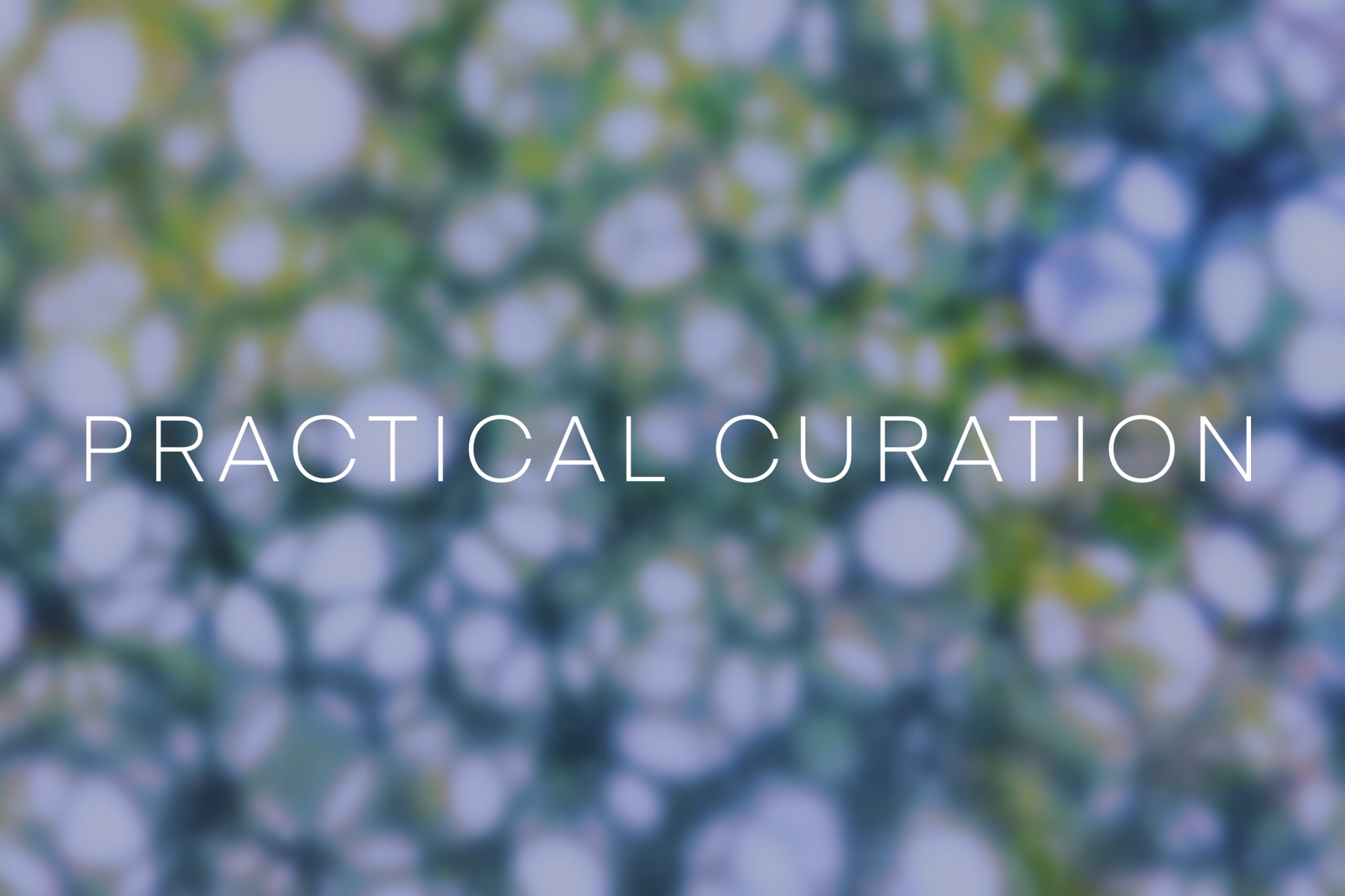
Introduction
I have taken note of the statement that Julie Louise and guest lecturer James Clegg made in the Week 6 lecture on curating an exhibition in an hour. They repeated the idea that curation is like balancing plates, moving between different areas of coordination to simultaneously realise each component of the curatorial project into a final cohesive exhibition. This allows a curator to embrace the curatorial process and act in a responsive way to simultaneously move all components of the project to completion, rather than doing one at a time. As a result, for this micro exhibition, I decided to frame my search for artists with the preliminary theme of ecological presents, with the knowledge that this would later be refined. After analysing my three selected artists and anticipating the relationships between pieces, I have identified intersections of commonality between the pieces, with new themes emerging through the dialogue of posing these pieces together in the same space. I will conclude this post by forming an exhibition goal, and an exhibition title.
Emerging themes
Mending:
Both Layla Knox’s work and my own explore ideas of nurture. Knox iterates this through the material use of wool in Nettle Weaving, where natural materials are brought together in weavings. Wool offers a sensation of comfort, and weaving is a form of craft that the observer will understand is a result of intensive interaction and close attention with the material. The found objects that she works with are elevated to new levels of value. Similarly, my darned piece Darned communicates something similar. We only choose to mend things of value, whether sentimental or monetary; it is a symbol that we are not willing to part with something and are willing to put in the effort to mend it.
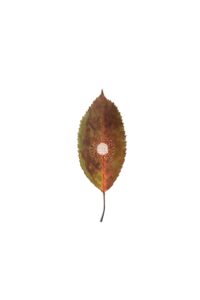
Harry Mayston, Darned (2025), Bronze thread and found leaf, Photographed by Harry Mayston (06.04.25)
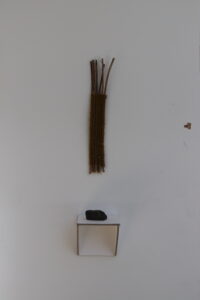
Layla Knox, Nettle Weaving (2025), Found Nettle Stalks and Yarn, Photographed by Harry Mayston (06.04.25)
Interconnectivity:
All the pieces ask us to question the role of our actions within a wider context of events. Antrobus’s work does this in the most direct way, focusing on the cause and effect of individual actions and happenings, bearing reference to the cause and effect present in chaos theory. We are assured that everything is connected whether we see it or not. Knox prompts us to consider our place within larger systems of the Anthropocene; the attentive acts of painting contrast with the minimalist and constructive notions suggested using breezeblocks in the display of Chapel Painting II, we are called to recognise our own role within the processes of absence as an expense of capitalistic construction. Lastly, the use of lichen imagery within the paper patterns of my work is significant of connection and mutualistic relations. Lichen is a symbiotic organism, composed of a fungus and an alga, only coming together when an environment would otherwise leave these organisms unable to survive (Sheldrake, 2021). Lichen is used as a metaphor for human and non-human relations, leading the audience to consider their own sympoiesis with, and responsive relationship, between ourselves and the world.
This collection of artwork asks the viewer to look beyond the scope of their own lives, fostering the ecological self (Mathews, 2021) and exploring the repercussions of actions in the world, whether it is in relation to other organisms or infrastructure in the present, or the ripples that they make extending into the future.
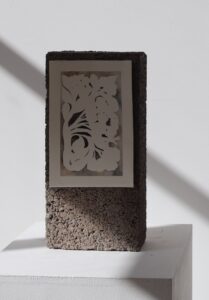
Layla Knox, Chapel Painting II (2025) Mounted on Breezeblock, image provided courtesy of the artist.
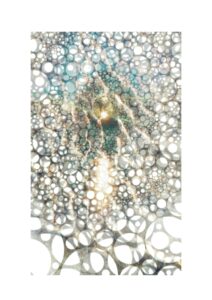
Example of pattern inspired by lace lichen, Harry Mayston, Herirophany (2025), Photographed (04.03.25)
Reframing Ecological Narratives
I believe that both the notion of interconnectivity and nurture can be iterated with notions of reciprocity. Robin Wall Kimmerer highlights reciprocity as a core theme in her book Braiding Sweetgrass (2013), locating it as a concept that unites the human and the non-human, alluding to a responsibility for caring for the other. Acts of taking must correspond to gratitude and giving. For Kimmerer (2013), this is based on the Native American wisdom and gift philosophy. The components of nature that have enabled humanity to flourish are conceptualised as gifts, and ones that we should be thankful and responsive to.
Kimmerer iterates mycorrhizal fungus as a microcosm of reciprocity. Trees are connected underground with this division of fungi, attaching to roots by either acting as an extender, or growing into the cells of the tree root in a more traditional mutualistic relationship. The tree offers sugars to the fungus, while the fungus extends the capability to absorb nutrients and water from the soil. Additionally, mycorrhizal fungus connects trees, allowing for a form of communication based on the flow of charged particles that has frequently been compared to the movement of chemicals in the synapses of the brain; this has led to discussion of forests as thinking organisms. Trees send nutrients to early saplings, fostering growth, while dying trees have been observed to distribute their remaining sugars to nearby trees (Simard, 2021). This relationship has been approached with a personification influenced by our own cultural capitalist narratives. Writers discuss this relationship from the perspective of what each organism gains from the relationship, rather than what they give. Ecologist Susanne Simard (2021) writes about plants without chlorophyll, only able to grow from a dependence on the sugars offered from neighbouring plants. Simard (2021) writes that these plants ‘steal’ sugars from underground mycorrhizal networks. However, I believe that this is a projection of our own standards. It would be just as accurate to say that the neighbouring plants gifted sugars to their adjacent organisms.
Conclusion
Attention to reciprocity, interconnectedness and the reframing of ecological narratives of gifting offer a more specific framing to my project. I will model the title of this exhibition on Kimmerer’s notions of reciprocity; ‘Mycorrhizal’. I will also use connective fungal imagery to build a visual identity for the project.
An exhibition goal has also emerged: to allow an audience the space to recognise their place within an interconnected system of nature and question the capitalist beliefs that infiltrate the ways we perceive nature.
Influences on my individual speculative project.
By completing this adjacent task, I have begun to think about the thematic titling and framing of my ‘Weird Frictions’ project. Many of the art pieces that I have proposed deal with issues pertaining to the human and the nonhuman. Some of the imagery that I develop as part of the exhibition identity may have space for crossover to my assessed speculative project. Lastly, I think that reciprocity can be utilised as a methodological way of thinking; it may be helpful to think of how uniting different cultures and themes in the material unification of art in one space creates an interconnected network of meanings where pieces are gifted meaning from the inter-artwork dialogue that develops (such as the relation between my own work and the work of Romy Antrobus, where pieces inherit meaning from the other).
Bibliography.
- Kimmerer, R.W. (2013). Braiding Sweetgrass. Braiding Sweetgrass: Indigenous Wisdom, Scientific Knowledge and the Teachings of Plants. Minneapolis, Minnesota: Milkweed Editions.
- Mathews, F (2021). Ecological Self. S.L.: Routledge.
- Sheldrake, M. (2021). ENTANGLED LIFE : how fungi make our worlds, change our minds & shape our futures. S.L.: Random House.
- Simard, S. (2021). Finding The Mother Tree. New York: Alfred A. Knopf.



